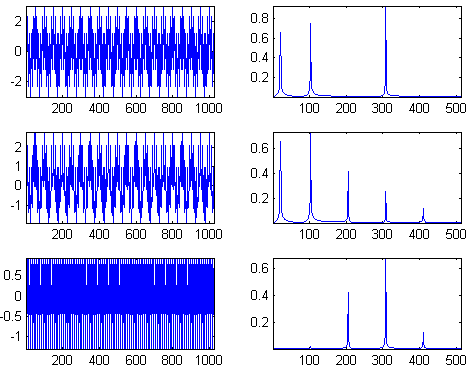What you might be forgetting is that dwt does downsampling. After filtering (low-pass or high-pass), the filtered signal is subsampled. In order to keep the number of samples. So aliasing may occur, depending on the quality of the filters.
And db2 is a quite poor filter. So if you idwt either approx or details, by replacing the other coefficients by zeros, you almost get your coefficients in order: on the top, the original signal, the two low frequencies in the second plot, the high frequencies in the third plot. Of course you have some aliasing, due to the poor resolution.

Try the attached code with db24, you will get much less artifact.

What happens now with the approximation and the details? My interpretation is that the approximation is now sampled at $500$ kHz, and the details too, except that it is now aliased to the base-band:

and they need to be unmixed by reciprocal filters of the idwt.
The FFTR.m code should be downloaded.
But why study sines with discrete wavelets?
f = [20/1000 100/1000 300/1000];
nSample = 1024; time = (1:nSample)';
data = cos(2*pi*time*f);
dataSum = sum(data,2);
waveName = 'db2';
[a,d] = dwt(dataSum,waveName);
z = zeros(size(a));
dataSumD = idwt(z,d,waveName);
dataSumA = idwt(a,z,waveName);
timeAD = 1:2*length(a);
timeAD=timeAD(1:2:end);
figure(1)
subplot(3,2,1)
plot(time,dataSum);axis tight
subplot(3,2,2)
plot(FFTR(dataSum));axis tight
subplot(3,2,3)
plot(time,dataSumA);axis tight
subplot(3,2,4)
plot(FFTR(dataSumA));axis tight
subplot(3,2,5)
plot(time,dataSumD);axis tight
subplot(3,2,6)
plot(FFTR(dataSumD));axis tight
figure(2)
subplot(2,2,1)
plot(timeAD,a);axis tight
subplot(2,2,2)
plot(FFTR(a,2));axis tight
subplot(2,2,3)
plot(timeAD,d);axis tight
subplot(2,2,4)
plot(FFTR(d,2));axis tight
So you have the code, I do not know whether you did stuff correctly, and wavelets are quite useful if used widely on signals that are worth it. Sines typically are not on the list.




fftoutput, code) $\endgroup$